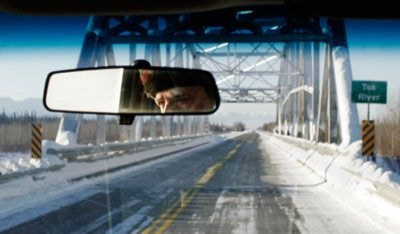‘You’ve got to break the horns off, and get all the meat out of there,” said Marc Bloch, while holding the curved horn of a Dall sheep in one hand, and the bleached crown of its skull in the other.
He grimaced, miming the effort needed to separate the two. “Otherwise, when the flesh dries up, the horns will be loose — it’s no good.”
Bloch’s Big Game Taxidermy workshop, in the garage of his home on Takhini Hot Springs Road, was a little empty on Monday, with only one project underway.
It’s an unusual situation for Bloch, who’s spent the last 11 years running a successful taxidermy business in his native Fluh, Switzerland.
He moved to the Yukon in May; his wife Tamara grew up here, and they wanted to return.
“I knew it was going to happen for a few years,” said Bloch, of shutting down his Swiss business. “I got rid of everything, sold it off … the tools, tables … everything.”
He kept only the items he would need in the Yukon: Polyurethane mannequins for coyotes and wolverines — a drawer full of glass eyes, and his awards from European taxidermy competitions.
“It’s tough,” he said, about starting over from scratch. “I’m busy with my house, the property — but with no work, I’m going a little crazy.”
Bloch hung out his shingle a few weeks ago, joining a small group of fewer than half a dozen taxidermists in the territory.
“The Yukon’s a good place to do business,” he said, adding that he named his business Big Game Taxidermy, because that’s what international hunters are after, that’s what people think of when they hear Yukon.
Bloch hopes a good working relationship with local outfitters will keep hunters with deep pockets bringing work his way. If they can spend US$20,000 to shoot a sheep, getting that sheep mounted is worth it. Bloch said he’s got a few more projects coming in this week.
For Bloch, there is a clear distinction between hunting and taxidermy. In fact, he said he’s not so interested in hunting — he prefers fishing and kayaking.
He was a member of a hunting society in Switzerland, but found himself at odds with the mentality of the members — “I didn’t like how it was, with the drinking and partying — it seemed like traditions were being lost, like the ethical approach, the skilled hunt, a respect for nature. It’s not where I wanted to be.”
Growing up, he would go to museums and see the animals — he was curious about the work behind the elaborate displays.
His interest in animals and nature, combined with a knack for building and model making, culminated in an apprenticeship with one of the busiest taxidermists in Europe.
After he completed his training, he had a few lean years. Eventually he made a name for himself by winning the top prize, “best in show” at the 2003 Swiss Taxidermy Competition, with a full-body fallow deer. He also won European awards for a boa constrictor and a red fox project.
“After that, I didn’t have to advertise,” he said.
He got used to being busy, and his high-standards meant long hours in the shop. “I can’t stop until it’s perfect — I don’t look at my watch when I’m working,” he said. “I burnt myself out a lot, back in Switzerland.”
Even though the work was plentiful, he never wanted to bring in a helper. “I’m difficult,” he laughed. “I need to be by myself … my apprentice quit.”
“Taxidermists are strange people — lone wolves,” he added.
“It’s more than a profession. It’s a passion, an art.”
He’s worked on everything from parrots to tigers — and says that the smaller the animal, the more difficult to do a good job. Now that he’s in the Yukon, he’d love to get the chance to work on a wolverine, something he’s never done.
One project Bloch won’t accept is pets — “Even the world champion couldn’t do that, and satisfy the client,” he said.
“They’re too familiar with the animal while it was alive, it would never have that quality.” He received about a dozen calls a year to do pets, and always turned them away.
His ultimate goal is to give a sense of “aliveness” to the piece — something natural. “You’ve probably seen those animals that are growling, fangs and claws … it’s overdone. I hate that. I want to show them as they are in nature.”
His pursuit of quality has gone as far as getting hunters to bring a full animal carcass to his shop so he can do the whole process himself, from start to finish. “Obviously that’s not very practical, it didn’t happen that often,” he said.
Instead, he offers advice to hunters on how to prepare the animal for taxidermy.
His website, www.yukontaxidermy.com — has all kinds of tips on how to get the best results out in the field — everything from “caping” to “splitting the eyelids and lips.”
Making pieces for competition is Bloch’s way of improving — and pushing himself beyond day-to-day work. “If a client likes it, that’s good — but these competition judges really know what to look for.”
Even though he’s been recognized for his quality workmanship, he’s always looking to improve. “When you think you’ve got it perfect, you’re lost.”
